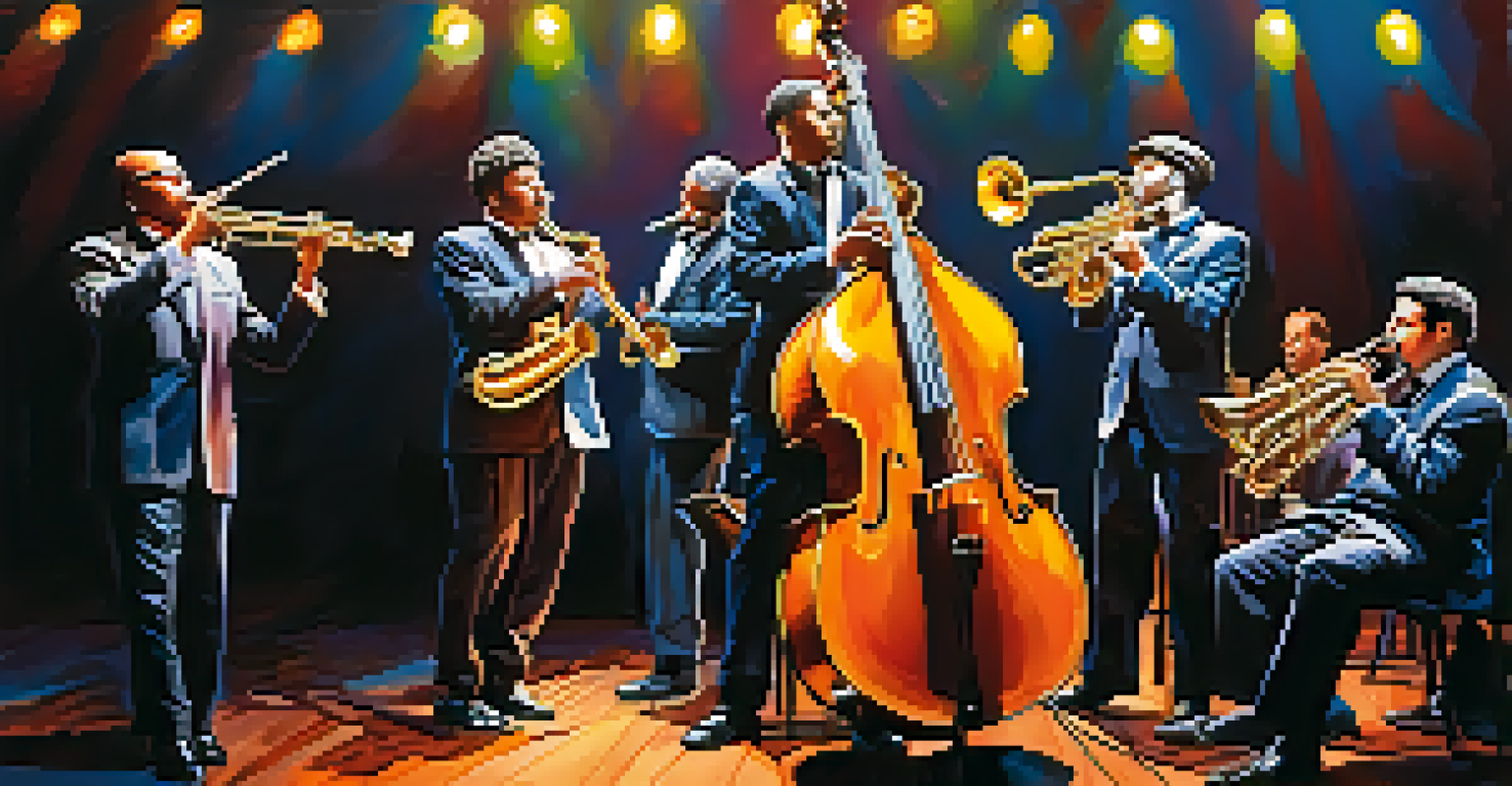The Interplay of Sound Waves and Silence in Music Composition

Understanding Sound Waves: The Building Blocks of Music
Sound waves are vibrations that travel through the air, creating the music we love. These waves are characterized by their frequency and amplitude, which correspond to pitch and volume, respectively. Think of sound waves like ripples on a pond; they expand outward, influencing everything they touch.
Music is the shorthand of emotion.
In music, different instruments produce unique sound waves, contributing to the overall texture and harmony. For example, the deep tones of a cello resonate differently than the bright notes of a flute. This variety adds richness to compositions, allowing composers to experiment with contrasting sounds.
Understanding how sound waves interact is crucial for composers. By layering these waves, they can create complex harmonies and melodies that evoke emotions, guiding the listener through an auditory journey.
The Role of Silence: Music's Unsung Partner
Silence in music often goes unnoticed, yet it plays a vital role in composition. It provides a pause, allowing listeners to absorb the sounds that have just played. This contrast between sound and silence can create tension, anticipation, or even relief, enhancing the emotional impact of a piece.

Consider the famous composer Ludwig van Beethoven, who masterfully used silence in his works. In his Symphony No. 5, the iconic 'short-short-short-long' motif is punctuated by brief silences that heighten the drama and urgency. These moments of stillness can be just as powerful as the notes themselves.
Sound Waves Create Musical Texture
Different instruments produce unique sound waves, enriching compositions and enabling diverse auditory experiences.
Silence also allows composers to highlight specific musical ideas. By intentionally placing quiet moments within a piece, they can draw attention to particular melodies or harmonies, making them stand out and resonate with the audience.
The Dance of Sound and Silence: A Delicate Balance
The interplay between sound and silence is akin to a dance, where each element influences the other. Composers must find the right balance to create a cohesive piece that feels dynamic and engaging. Too much sound can overwhelm, while excessive silence can lead to disinterest.
Silence is the ultimate weapon of power.
For instance, jazz musicians often improvise, playing off each other's sounds while leaving space for silence. This creates an organic flow where the music feels alive and spontaneous. In this way, both sound and silence become essential partners in the creative process.
In classical music, composers like Claude Debussy embraced this interplay, using silence to create atmospheric effects. His piece 'Clair de Lune' features gentle notes interspersed with thoughtful pauses, inviting listeners to reflect on the beauty of both sound and silence.
Exploring Dynamics: The Volume of Silence
Dynamics in music refer to the variations in loudness between notes or phrases, and silence plays a crucial role in this aspect. By incorporating silence, composers can create a more dynamic range, enhancing the overall listening experience. Imagine a rollercoaster ride; it's the dips and rises that make it thrilling.
In many compositions, a sudden drop in volume, followed by a moment of silence, can catch the listener off guard, making the subsequent sounds even more impactful. This technique keeps audiences engaged, as they anticipate what comes next. The interplay of sound and silence thus becomes a powerful tool for emotional storytelling.
Silence Enhances Musical Impact
Strategic use of silence in music creates emotional tension and highlights specific melodies, drawing listeners in.
Composers like Igor Stravinsky utilized this dynamic contrast to great effect in pieces like 'The Rite of Spring.' The dramatic shifts in volume, punctuated by silence, create an electrifying experience that captivates and intrigues listeners, demonstrating the artful use of silence within a vibrant soundscape.
Cultural Perspectives: Sound and Silence Across Genres
Different musical genres approach sound and silence in unique ways, influenced by cultural backgrounds and traditions. For example, traditional Indian music places significant emphasis on silence, allowing space for improvisation and expression. This cultural context shapes the listener's experience, making silence an integral part of the performance.
In contrast, rock music often prioritizes sound, with powerful riffs and energetic beats dominating the space. However, even in rock, moments of silence are strategically placed to enhance the emotional weight of a song, as seen in tracks like 'Stairway to Heaven' by Led Zeppelin. Here, silence acts as a bridge, connecting different musical ideas.
Exploring these cultural nuances reveals how diverse approaches to sound and silence contribute to the richness of music. Each genre offers a unique perspective, reminding us that the interplay of sound waves and silence is a universal language that transcends boundaries.
The Creative Process: Composing with Sound and Silence
When composing music, artists often experiment with sound and silence to discover their unique voice. Many musicians start with a melody or rhythm, but the spaces in between—those moments of silence—can inspire new ideas and directions. It's in these pauses that creativity can flourish.
For instance, a songwriter might write a powerful chorus but choose to leave a silence after the last note to let the emotion sink in. This intentional use of silence can amplify the message of the song, creating a lasting impression on the listener. The creative process becomes a journey where sound and silence collaborate.
Cultural Views Shape Sound and Silence
Various musical genres interpret sound and silence differently, reflecting cultural influences and enhancing the listening experience.
Ultimately, the way composers approach sound and silence can transform a simple tune into a captivating masterpiece. By embracing both elements, they can craft pieces that resonate deeply with audiences, ensuring that their music remains memorable and impactful.
The Future of Sound and Silence: Innovations in Composition
As technology evolves, so does the way we create and experience music. Digital tools allow composers to play with sound waves and silence in innovative ways, pushing the boundaries of traditional composition. From electronic music to film scores, the possibilities are endless.
For example, sound designers often manipulate silence to create tension in film soundtracks. By layering sounds over moments of silence, they can evoke fear, excitement, or nostalgia, enhancing the viewer's emotional experience. This modern approach highlights the ongoing relevance of sound and silence in storytelling.

Looking ahead, the interplay of sound and silence will continue to shape the music landscape. As artists experiment with new technologies and styles, they will undoubtedly discover fresh ways to harness these elements, ensuring that the conversation between sound and silence remains vibrant and evolving.